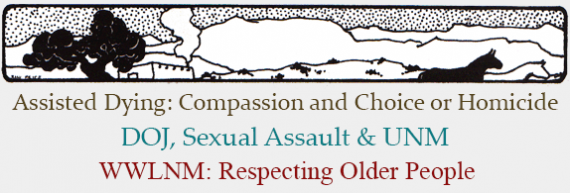Assisted Dying: Compassion and Choice or a Form of Homicide?

Is there a meaningful difference between helping those suffering lingering miseries to end their lives and torments if they can’t bear them any longer and helping a terminally ill patient near death’s door to exit peacefully and painlessly as a matter of choice? In other words, what is the difference between physician-assisted dying and physician-assisted suicide?
Two decades ago a dear friend decided to end her own life when she was in her late 80s. She knew she was going blind. She was suffering from severe arthritis and worried she would no longer be able to live alone in her home of over 60 years. She was a charter member of what was known in those days as the “Hemlock Society,” an organization that gave detailed information about ending life to aged or terminally ill patients and lobbied for physician assisted euthanasia for consenting patients on their death beds.
In her suicide note my friend wrote, “we treat our pets better than we treat ourselves.” She then put herself “to sleep” using a combination of barbiturates, brandy, and a plastic bag. Some of her friends were dismayed by her suicide and offended by her note. Some understood completely and agreed she had the human right to make such a choice. She feared a long, lingering, financially ruinous death, alone in a virtual vegetal state with no work she could do and no meaning left in her life as she had lived it over the decades as a highly productive writer.
The physician who prescribed her barbiturates as a sleep aid probably had no clear idea that she would use them to commit suicide. So her choice to end her own was effectively beyond the realm of legal ramification.
But New Mexico this year, or next, might see a serious political and moral struggle over physician-assisted dying. One side will describe it as “destroying life” and the other will say that helping a dying person die without needless pain is not helping them commit suicide but rather is the ultimate measure of palliative care.
In January last year, New Mexico joined the four other states in the country that permit physician-assisted dying for terminally ill patients. This event slipped under the radar of many people here, other than those in the “right to die” movement. The New York Times reported then that a “state court in New Mexico said…that terminally ill residents have a constitutional right to obtain ‘aid in dying,’ a ruling that could make New Mexico the fifth state to allow doctors to prescribe fatal drug doses that suffering patients can use to end their lives.”
The case was brought by two physicians who “sought protection against prosecution” if they gave a terminal cancer patience a fatal drug dose, the Times said. Judge Nash, who was retained as a Bernalillo County judge in last November’s election, wrote in her opinion “This court cannot envision a right more fundamental, more private or more integral to liberty, safety and happiness of a New Mexican than the right of a competent, terminally ill patient to choose aid in dying.”
Nash’s judgment was taken to the State Court of Appeals by then Attorney General Gary King in March last year. It might not be until the middle of this year that the appeals decision will be made. After that, in all likelihood, it will go to the New Mexico Supreme Court regardless of the Court of Appeals decision. Our new Attorney General Hector Balderas will have hard decisions to make. It’s possible he could pursue the appeal to the state Supreme Court in hopes Justices would broaden the scope of Judge Nash’s decision to include the whole state. Ultimately the constitutional right to assisted dying in New Mexico could well find itself churning through the state legislature over the next few years. Right now assisted dying is legal in Bernalillo County, but not in the rest of the state.
The key dispute will be over deciding if a dying person consenting to end their own suffering can legitimately be called suicide. If it’s not, then a physician prescribing a fatal dose of drugs at a patient’s request could be said to be merely providing care and comfort at the inevitable end.
I would support such a definition as a legislator with my knowledge of the history of agonizing death in my own family. My parents and many of my late friends could have been saved meaningless pain if such a definition and law had been in place when they were dying.
If Judge Nash’s decision does inspire legislation down the road, it will be fascinating to see who opposes it and who funds that opposition. It might seem cynical for me to say that I wouldn’t be surprised to see, leading the charged against legalizing assisted dying in New Mexico, lobbyists for the healthcare industry which, as our population ages, stands to make billions of dollars on warehousing the aged even if they would prefer not to be kept alive as cash cows in nursing homes.
It’s a fearful thing to imagine the corporate health care industry working against compassionate assisted dying, funding religious groups and other “pro-life” elements to champion obliquely the idea of keeping us all alive until our bank accounts are empty and our investments wiped out.
From my perspective there is no reasonable argument, even on so called moral grounds, against people in unbearable physical or emotional pain choosing to end their own suffering and getting help to do so.
At this point about the only ones with immediate access to a “compassionate” end of life exit are pistol packin’ members of the NRA.
DOJ Investigation of Sexual Assault at UNM

The epidemic of rape and sexual harassment at American colleges and universities, and in society as a whole, is the clearest sign that misogyny and sexism are still dominant realities in our culture.
The University of New Mexico, late last month, became the second school in the nation, after the University of Montana in Missoula, to be investigated by the U.S. Department of Justice (DOJ) for its handling of sexual assault and misconduct cases.
The DOJ is sizing up 83 other institutions of higher learning for future investigations.
It’s about time that what President Obama calls “the quiet tolerance of sexual assault” be rejected in our country and that all of us, in the President’s words, “refuse to accept what’s unacceptable.”
The social penalties today that women who are victims of sexual crimes must endure for witnessing against their attackers are as terrible as they’ve ever been. They are socially battered, humiliated, ridiculed and can even be accused of seduction in brutal ways. It is true, that some men are falsely accused of rape. But the general misogynistic and sexualized social climate of campus life in America produces perhaps hundreds, if not many hundreds, of unreported sexual crimes a year at individual schools across the country. The DOJ reports that 80% of all rapes on campus go unreported. That means some 1 in 5 rapes are reported. The social pressure on the victimized can be almost as great as the trauma of the rape itself.
Misogyny, and its attack dog sexual behavior, is a societal disgrace. Like racism, it should never be tolerated anywhere, and certainly never on university and college campuses. It needs to be acknowledged, condemned and stopped.
The DOJ has apparently given no reason why UNM has been singled out at this time for an investigation. It’s surprising to me since I know something of the considerable lengths to which UNM has gone to begin confronting the social and personal calamities of rape culture on campuses.
Has the DOJ picked out UNM because of the general climate of violence in Albuquerque, including the long history of unconstitutional police violence that has escalated since 2009 and badly tarnished the tenure and reputation of Mayor Richard Berry?
Whatever the immediate reason, UNM will face intense scrutiny as really most colleges and universities should. Being under a national microscope, however, will give UNM an opportunity to become a pioneer in the long struggle against sexual violence. It could set university goals and policies in such a way that UNM becomes a beacon of zero-tolerance for sexist hate crimes like rape.
When the DOJ investigates the school it will find UNM already working diligently to remedy the age-old national crisis of sexual violence. Last year, the Mercury interviewed on Insight New Mexico, Summer Little, the person in charge of UNM’s efforts to defuse rape culture and sexual misogyny on campus. Little is the director of UNM’s Women’s Resource Center and the chair of something called SMART, the campus Sexual Misconduct and Assault Response Team.
Little was eloquent about what the ubiquitous and degrading social trauma that hurts so many young people – the vast majority of them women -- across the country and in New Mexico. UNM has been working to focus itself on preventing and responding to sexual violence since 2011. And I found Summer Little to be inspiringly articulate, devoted, and informed about the issues involved, national trends and state of the art approaches to prevention and victim care. It was an inspiring interview. You can see it here.
With my granddaughter going off to college this year, I want UNM to set the tone nationally for a campus free of sexual assault so that other colleges and universities will see that such a goal can be articulated and pursued.
I would like to see signs at UNM which not only proclaim UNM as a smoke free campus, but also a sexual assault-free campus. Is that an impossible goal? Isn’t sexual aggression simply a matter of human nature? The answer is “no” to both questions. Sex is a culturally regulated human “activity.” American colleges and universities clearly have not been regulating campus culture in such a way that sexual violence is simply taboo.
It can be done. Make it known to all social organizations on campus that tolerating sexual assault of any kind will get them banished from college life. Make it known that coaches will lose their jobs over issues of sexual violence by members of their teams. Coaches, as leaders, should acculturate their players in the decencies of social relations between men and women. Don’t let anyone, including predatory faculty members, get away with “sex for grades” harassment.
Tolerate none of it. Don’t just talk about it. Mean it. Change the culture of UNM so that campus sexual assault and sexual misconduct become as close to unthinkable as humanly possible.
I hope the DOJ investigation stimulates UNM’s Regents, faculty and administration to take this as an opportunity to transform UNM into a nationally recognized leader in creating sexual assault-free campuses. Now’s the time to do it!
Why We Love New Mexico: Respecting Older People

When I grocery shop at John Brooks market in the North Valley I consider it a uniquely New Mexican experience. It’s because its cashiers and management staff have been working there for decades. They are older people and they are, by now, old friends. John Brooks hires young people too. But customers get the feeling that they are working their way into the company doing jobs suited for young backs and muscles. It’s a great environment in which to shop because its sense of community – and the care and civility that brings – is so sincere.
If you’re as old as I am – 74 – you most likely have a growing accumulation of kindnesses extended to you by people in New Mexico who tend to like and respect those who’ve lived a long time. This has not been my experience in mainstream American places like certain parts of Los Angeles and New York and Chicago, or in franchise and corporate Albuquerque. The mainstream consumer culture more often sees white haired folks as slightly suspicious, or something of a bother, or worse as an unwilling client for costly and dubious products. Older people in the mainstream often are seen as impediments to young people or even competitors.
But in ethnic America, if I can use such a term, and in a place like New Mexico with majority minorities, older people often have a vital role to play in many communities. They are seen as the anchors of wisdom and stability. They are at the center of secular and spiritual leadership.
In Pueblo villages and on Navajo land, in Hispanic farming and cowboy culture ranching communities and in African American neighborhoods, older people who have grown humbler and wiser with age are looked to for an understanding of core values. And older people often respond by trying to live up to their more useful and strategic role in family and community life.
In cultural worlds beyond the consumer culture, older people represent a stage in the cycle of life and death. In the mainstream cult of youth, the life cycle has been photo-shopped and made-up out of existence, even to the extent of hiding those many, and unlucky, older Americans who do survive into advanced age in nursing home concentration wards where they slowly perish out of sight, out mind.
In a powerful new book on aging and dying titled Being Mortal: Medicine and What Matters at the End surgeon Atul Gawande writes “The waning days of our lives are given over to treatments that addle our brains and sap our bodies for a sliver’s chance of benefit. They are spent in institutions – nursing homes and intensive care units – where regimented, anonymous routines cut us off from all the things that matter to us in life.”
This is the fate of many older people in mainstream American culture. It has become the standard, the norm of bad luck in old age. Bad luck haunts people of all cultures, of course. But if your culture has a life cycle view of life and death like that found in many ethnic and rural communities in New Mexico, chances are less likely that older people will find themselves tripping the trap set for the aging in mainstream America.
When I understand that I am living, by choice and inclination, in what some might call “traditional New Mexico,” I feel my age is an asset and that I have a usefulness, the exact nature of which is beyond my consciousness. I find myself then living in a life cycle world, not wishing to be young and not afraid of being old. This traditional view is so present in much of New Mexico that it can inspire and empower even someone from mainstream America like me, someone who has rebelled against its many inanities most of his life. I imagine it was that rebellion that brought me to New Mexico in the first place. And how right I was to choose life here.
(Photos: IV drip by Nic McPhee / CC; Man and great-grandson by Todd Baker / CC)




Responses to “Provincial Matters, 1-12-2015”